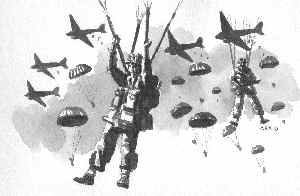Table of Contents | Assault from the Sky | Assault from the Sea | Advance Inland | Selected Awards | Reviews | Order of Battle
British Gallantry Awards | To Order
Outline of the Canadians on D-Day
Assault from the Sky
Airborne Assault
Once the final decision had been taken by the Supreme Allied Commander, General Dwight Eisenhower, on the 6th of June, 1944, to proceed with the invasion, the air forces and airborne troops were the first to move into action. The aircraft carrying these forces dramatically announced to the English countryside that the invasion was on, as reported by a Canadian Spitfire pilot: "During the early hours, most persons were awakened by a roar of planes overhead and the increased activity brought many from their beds. A great armada was passing overhead & [it was] one of the most magnificent and thrilling sights we have ever witnessed."
 The 6th British Airborne Division was assigned to land on the eastern flank of the bridgehead. The 1st Canadian Parachute Battalion was part of this division and, as one of its tasks, was to destroy the bridge over the Divette River and to capture an enemy strong point at the village of Varaville. Although poor navigation and German anti-aircraft fire disrupted the parachutists, a small group of 38 Canadians managed to rendezvous on the ground and these proceeded to attack Varaville. When the senior officer, Major H.M. MacLeod was killed by the German machine gun and anti-tank fire, Captain J.P. Hanson took over to continue the attack. They were successful, capturing their objective against a numerical strong enemy force, and Captain Hanson was awarded the Military Cross.
The 6th British Airborne Division was assigned to land on the eastern flank of the bridgehead. The 1st Canadian Parachute Battalion was part of this division and, as one of its tasks, was to destroy the bridge over the Divette River and to capture an enemy strong point at the village of Varaville. Although poor navigation and German anti-aircraft fire disrupted the parachutists, a small group of 38 Canadians managed to rendezvous on the ground and these proceeded to attack Varaville. When the senior officer, Major H.M. MacLeod was killed by the German machine gun and anti-tank fire, Captain J.P. Hanson took over to continue the attack. They were successful, capturing their objective against a numerical strong enemy force, and Captain Hanson was awarded the Military Cross.
Tactical Air Support
Thirty minutes before H Hour, the Allied tactical air forces began to attack the German beach defences all along the landing beaches. On the British-Canadian front, this support was provided by the Royal Air Force's 2nd Tactical Air Force, whose Number 83 Group contained fifteen Royal Canadian Air Force squadrons along with an RCAF reconnaissance wing of three squadrons.
On Juno Beach, Squadron Leader H.H. Norsworthy's Westmount [Number 439 Fighter Bomber] Typhoon Squadron bombed gun positions on the beach at Courseulles in support of the 3rd Canadian Infantry Division. Diving through billowing clouds of smoke and debris hurled up by the intense naval bombardment, the pilots attacked two enemy batteries. In the afternoon, as the three Typhoon squadrons flew inland to make armed reconnaissances of the area around the city of Caen. Here they bombed roads along which armoured cars and trucks were moving and later surprised a long armoured column.
Table of Contents|Assault from the Sea
 The 6th British Airborne Division was assigned to land on the eastern flank of the bridgehead. The 1st Canadian Parachute Battalion was part of this division and, as one of its tasks, was to destroy the bridge over the Divette River and to capture an enemy strong point at the village of Varaville. Although poor navigation and German anti-aircraft fire disrupted the parachutists, a small group of 38 Canadians managed to rendezvous on the ground and these proceeded to attack Varaville. When the senior officer, Major H.M. MacLeod was killed by the German machine gun and anti-tank fire, Captain J.P. Hanson took over to continue the attack. They were successful, capturing their objective against a numerical strong enemy force, and Captain Hanson was awarded the Military Cross.
The 6th British Airborne Division was assigned to land on the eastern flank of the bridgehead. The 1st Canadian Parachute Battalion was part of this division and, as one of its tasks, was to destroy the bridge over the Divette River and to capture an enemy strong point at the village of Varaville. Although poor navigation and German anti-aircraft fire disrupted the parachutists, a small group of 38 Canadians managed to rendezvous on the ground and these proceeded to attack Varaville. When the senior officer, Major H.M. MacLeod was killed by the German machine gun and anti-tank fire, Captain J.P. Hanson took over to continue the attack. They were successful, capturing their objective against a numerical strong enemy force, and Captain Hanson was awarded the Military Cross.